Guest Post
This mission of this blog is to share ideas about business analytics. One of the things I want to increasingly do this year is to feature more guest bloggers and do more interviews.
A few months ago, I came across Sanjay Shetty’s unique blog Communities R Us. His approach to blogging about social media topics is very visual. Sanjay and I ended up connecting via a recent blog post where we exchanged a few ideas. The idea of a guest post quickly developed. And here it is: Sanjay Shetty writes about his views on Social Business Intelligence.
Evolution of Social Business Intelligence: Human Business Intelligence
Social Media provides a fantastic opportunity for enterprises to gather enormous amount of business intelligence, whether it’s about their customers likes and dislikes, or whether it’s competitive intelligence. My earlier post and video covered quite a bit of ground. However, I’ve seen organizations limiting themselves and the power of the social opportunity in leveraging true human business intelligence.
So here’s the typical evolution of social business intelligence:
Social Business Intelligence Begins with Listening
 At first the experience is amazing, as you’re able to view in real time what people think about your brand, product or service. You realize the need to categorize the information so that it’s relevant to your various teams.
At first the experience is amazing, as you’re able to view in real time what people think about your brand, product or service. You realize the need to categorize the information so that it’s relevant to your various teams.
You finally begin to analyze the data.
Three steps: listen, categorize and then analyze to gain business intelligence. All hunky dory as of now.
But here’s the problem:
Data Overload
The problem being that the sole analyst, rather IT guy, who got the shiny new tool(s) to monitor the information flow from social channels and the sole community manager managing, reactions, engagement, customer support etc. are overwhelmed with the volume of data.
One possible solution organizations start thinking about is putting up a Digital Social Command Center, with an increased head count of people, maybe 3-4 people to manage this.
This solution works well for a short time.
I say short time because the problem here is that whether you’re successful or not with your social media efforts, the volume of people on social channels, and volume of data they generate is exceptionally large.
Here’s an example to illustrate the volume of data;
“More video is uploaded to YouTube in one month than the 3 major US networks created in 60 years” – Source http://www.youtube.com/t/press_statistics
So one might think that a better way to deal with this data onslaught might be to have better data filters in place.
Social Business Intelligence Tools
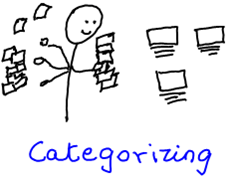 Social Business Intelligence tools are able to help by highlighting trends and measuring sentiment. However, filtering and/or categorizing the volume of data are something humans need to do.
Social Business Intelligence tools are able to help by highlighting trends and measuring sentiment. However, filtering and/or categorizing the volume of data are something humans need to do.
To say the least this is a challenging task.
Here’s a question to ask yourself, when is the last time when searching for information via Google or Bing, that you scanned up to page 10 of the search results.
Social Data is not Transactional Data
Most traditional business intelligence practitioners will find that traditional tools to analyze transactional data, do not adapt well to handling data generated by people across social channels as they are conversations, opinions and NOT data regarding orders placed by customers for XYZ product.
Social media is a two faced coin, it provides you the ability to gather massive amounts of data about your customers and competitors, and at the same time handling the massive data is challenging. However, the real problem is the approach organizations take to gather intelligence; the approach is not social in nature.
The Social Approach to Social Business Intelligence
The social approach to social business intelligence broadly involves 4 components to work together in tandem: Internal Teams, Partners, Brand Advocates & Social BI software.
Internal Teams
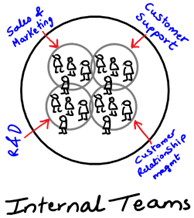 Data gathered via social channels is not just transactional data, it contains insights for not just your sales & marketing or communication teams, but it impacts customer support, customer relationship, research and product development teams.
Data gathered via social channels is not just transactional data, it contains insights for not just your sales & marketing or communication teams, but it impacts customer support, customer relationship, research and product development teams.
These teams need to work together as a connected whole in order to make sense of the volume of data, the team members are the ultimate filters and working together is necessary to fully leverage this data.
Partners
 In organizations where partners play a large role, for e.g. software product companies, where the partners provide installation, system integration and support functions. The integration of these partners is critical from another angle. You need their help and support in filtering the noise which can be huge. For e.g. negative news irrespective of whether it’s true or not can spread super-fast, whether it’s with regards to product upgrades or integration challenges etc. The partners are the people with hands on experience who will be able to tell truth from rumor along with the third component given below. Additionally, before an issue becomes a mass issue, they’re often the first to provide you true business intelligence about challenges with your products or services. Their feedback needs to be channeled back across your teams so that they are well prepared to handle it.
In organizations where partners play a large role, for e.g. software product companies, where the partners provide installation, system integration and support functions. The integration of these partners is critical from another angle. You need their help and support in filtering the noise which can be huge. For e.g. negative news irrespective of whether it’s true or not can spread super-fast, whether it’s with regards to product upgrades or integration challenges etc. The partners are the people with hands on experience who will be able to tell truth from rumor along with the third component given below. Additionally, before an issue becomes a mass issue, they’re often the first to provide you true business intelligence about challenges with your products or services. Their feedback needs to be channeled back across your teams so that they are well prepared to handle it.
Brand Advocates
 Brand Advocates are one of the ultimate helper components for your Social Business Intelligence. They’re your early warning system. By nature these passionate champions are typically the first to beta test your products and services. They’re also the first to vocalize to you their experiences and the first to defend you. They’re living breathing passionate exponents of your products. They’ll tattoo your logos, sing songs, compose videos and promote you endlessly. They’re often associated with your organization for a longer time than most of your employees. They’re the unpaid volunteer heroes. The advance insights provided by them is invaluable and they’re often present in places where your workforce doesn’t even exist. There are numerous organizations from Microsoft to Harley Davidson who’ve built an ecosystem to engage and support brand advocates.
Brand Advocates are one of the ultimate helper components for your Social Business Intelligence. They’re your early warning system. By nature these passionate champions are typically the first to beta test your products and services. They’re also the first to vocalize to you their experiences and the first to defend you. They’re living breathing passionate exponents of your products. They’ll tattoo your logos, sing songs, compose videos and promote you endlessly. They’re often associated with your organization for a longer time than most of your employees. They’re the unpaid volunteer heroes. The advance insights provided by them is invaluable and they’re often present in places where your workforce doesn’t even exist. There are numerous organizations from Microsoft to Harley Davidson who’ve built an ecosystem to engage and support brand advocates.
Social Business Intelligence Software
Oh yes, there is a place for the software as well. I’m not going to get deep into this, except to say, that it important to automate as much as possible. Check out Christoph’s blog post about this.
There are many more things in terms of systems and processes you need to put in place. These four components and taking the social approach will ensure a faster and better equipped organization to leverage business intelligence.
About the Author:
Sanjay Shetty is the founder of Communities R Us Consulting Services Pvt. Ltd. It helps organizations convert customers into Brand Advocates.
He blogs at http://blogs.communitiesrus.in/communityconnect

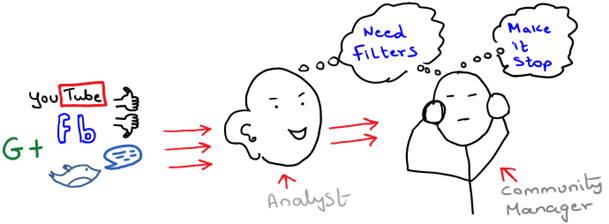

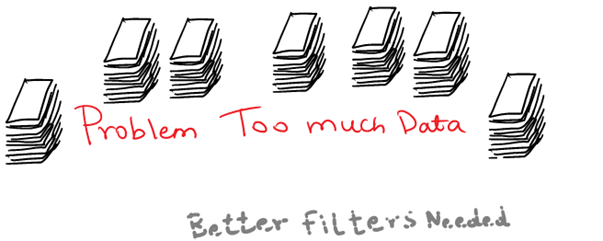
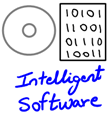


Comments
One response to “The Evolution of Social Business Intelligence – Guest Post”
If you are looking for social media business intelligence, I suggest you check out EvoApp. EvoApp provides users with vital data analytics and business intelligence solutions that drive a company’s success. Companies can make better use of social media data through analysis. Products like EvoApp’s MX provide users with valuable insights that are derived from social media data. These insights are crucial if a company aims to make informed business choices.
Social media conversations become more powerful when they are measured and analyzed to find patterns that are relevant to a business or industry. Social media monitoring tools are far less valuable than the social media business intelligence tool EvoApp. @catey_c